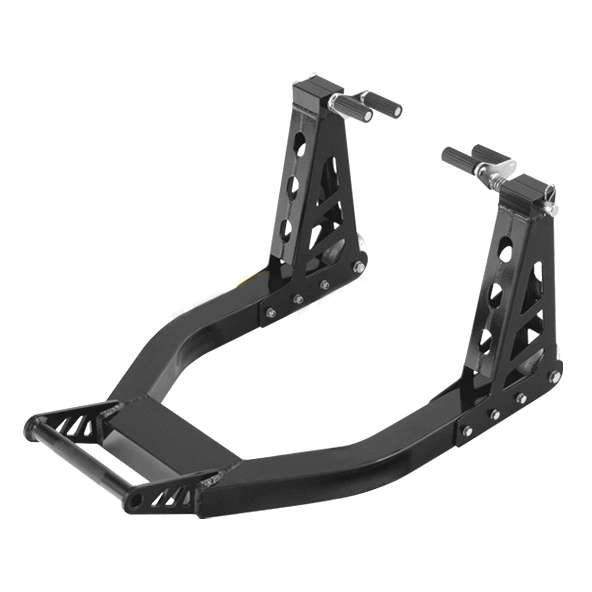Understanding Paddock Stands and Their Importance
Types of Paddock Stands
Paddock stands come in various designs to accommodate different motorcycle models and maintenance needs. The most common types include front wheel stands, rear wheel stands, and swingarm stands. Front wheel stands typically support the motorcycle's steering head or fork bottoms, while rear wheel stands lift the bike from the swingarm or spools. Swingarm stands are versatile and can be used on motorcycles with or without spools.
Benefits of Using a Paddock Stand
Utilizing a motorcycle paddock stand offers numerous advantages for motorcycle maintenance. It provides a stable platform for performing tasks such as chain lubrication, tire pressure checks, and brake inspections. By elevating the wheels, paddock stands reduce stress on tires and suspension components during storage. They also facilitate thorough cleaning of hard-to-reach areas, ensuring your bike remains in top condition.
Choosing the Right Paddock Stand
Selecting an appropriate paddock stand depends on your motorcycle's make and model. Consider factors such as weight capacity, compatibility with your bike's design, and the specific maintenance tasks you plan to perform. High-quality stands made from durable materials like steel or aluminum ensure longevity and safety during use.
Step-by-Step Guide to Setting Up a Paddock Stand
Preparing Your Workspace
Before beginning setup, prepare a safe and efficient workspace to reduce the risk of accidents. Choose a flat, non-slippery surface, free of oil spills, tools, or clutter that could interfere with balance or movement. Have all tools you might need within easy reach, and make sure the paddock stand is clean and fully functional. Wearing protective gloves and closed-toe footwear helps guard against minor injuries. Good lighting is also important to clearly see alignment points on your bike. Proper workspace preparation ensures a smoother, faster, and safer process when lifting your motorcycle.
Positioning the Motorcycle
Start by ensuring your motorcycle is upright on its side stand in a steady position. If you're using a rear paddock stand, align its hooks or supports with the spools or swingarm pads. For front stands, the positioning varies - some are designed to lift from under the forks, while others attach at the steering stem. Always double-check that the contact points are centered and stable before lifting. Incorrect positioning can cause the bike to slip or fall during elevation. Taking a few extra moments to line things up correctly prevents accidents and damage.
Lifting the Motorcycle
When lifting the motorcycle, follow the manufacturer's instructions closely to ensure safe operation. For rear paddock stands, hook the supports beneath the swingarm or spools and press down smoothly on the lever to raise the rear wheel. If you're using a front paddock stand, gently lift the bike’s front end before positioning the stand under the forks or headstock, then lower it gradually. Maintain even pressure and a steady hand throughout the process. Avoid sudden movements or jerks, as they can destabilize the motorcycle. A careful, methodical lift ensures the bike stays upright and secure.
Safety Precautions and Maintenance Tips
Ensuring Stability
Once the motorcycle is securely positioned on the paddock stand, gently rock the bike back and forth to ensure it is firmly balanced. All contact points between the stand and the motorcycle should be inspected to confirm a tight, non-slip grip. If you're using both front and rear stands, make sure the bike remains level and evenly supported. Avoid leaning or applying extra weight to one side, as this could cause instability. Taking a few extra moments to check alignment and balance can prevent costly accidents and make your maintenance process much safer.
Regular Inspections
To keep your motorcycle paddock stand in top condition, conduct regular inspections for wear and damage. Look closely at all structural components, including the bolts, brackets, and support arms. Worn-out rubber pads, bent metal, or corroded parts can compromise the stand's safety. Ensure all fasteners are tightened properly, and replace any damaged or missing parts as soon as they’re discovered. Cleaning off dirt and applying lubrication to any moving joints or wheels will also enhance functionality and longevity. Routine maintenance ensures your paddock stand stays safe and dependable during each use.
Storage and Transportation
Proper storage and handling of your paddock stand significantly contribute to its lifespan. When not in use, place the stand in a clean, dry, and cool area to avoid moisture buildup and rust. Avoid leaving it outdoors uncovered, as exposure to rain or sunlight can degrade materials over time. During transportation, secure the stand tightly in your vehicle or trailer to prevent movement or damage. For long-term storage, consider using a protective cover to shield it from dust, dirt, and humidity. These simple precautions will help maintain your paddock stand’s condition and reliability.
Conclusion
For motorcyclists, acing the utilization of a paddock stand is a must. You can keep your bike in good shape safely and effectively if you know about the different kinds of stands, what they're good for, and how to set them up correctly. Remember to prioritize safety, regularly inspect your equipment, and choose the right stand for your specific motorcycle model. If you keep in mind these tips, you'll be able to do a parcel of diverse support employments on your cruiser and keep it in incredible shape.
Contact Us
For more information about our high-quality paddock stands and other motorcycle maintenance tools, please contact us at info@runva.com.cn. Our team of experts is ready to assist you in finding the perfect solutions for your motorcycle maintenance needs.

_1737625693698.webp)


